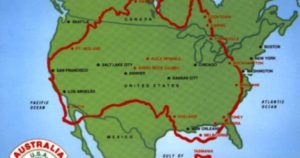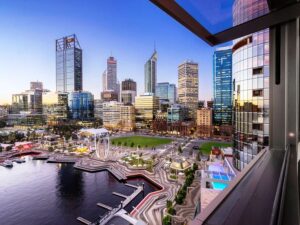» posted on Sunday, July 31st, 2022 by Linda Lou Burton
Looking For Ocean
 Originally Published July 30, 2020 by Linda Lou Burton posting about Perth, Australia from Little Rock, Arkansas – I told you it was a big country. If you want to imagine Australia-size against United States-size, my Canberra-Perth flight today (on my NDI RTW) is similar to traveling from Washington DC to Los Angeles via Atlanta, as I have a layover in Melbourne again. It looks like four hours, when you think of local times, but I’m crossing several times zones, so I resolve the issue by just not thinking about how long it takes. Even though it’s winter and gets dark in Perth about 5:30 PM, I’ll be happily settled at my hotel by then. In time for a beach walk right outside my door. And a toe wiggle in the Indian Ocean. It won’t be warm. Nor will it be cold. When it comes to latitude, Perth is similar to New Orleans, or north Florida.
Originally Published July 30, 2020 by Linda Lou Burton posting about Perth, Australia from Little Rock, Arkansas – I told you it was a big country. If you want to imagine Australia-size against United States-size, my Canberra-Perth flight today (on my NDI RTW) is similar to traveling from Washington DC to Los Angeles via Atlanta, as I have a layover in Melbourne again. It looks like four hours, when you think of local times, but I’m crossing several times zones, so I resolve the issue by just not thinking about how long it takes. Even though it’s winter and gets dark in Perth about 5:30 PM, I’ll be happily settled at my hotel by then. In time for a beach walk right outside my door. And a toe wiggle in the Indian Ocean. It won’t be warm. Nor will it be cold. When it comes to latitude, Perth is similar to New Orleans, or north Florida.
 Perth is a city of about 2.14 million sun-loving people, named after a city in Scotland, and capital of Western Australia. Like California, a rush to the area happened due to the discovery of gold in the late 19th century; during WWII it was a base for submarines operating in the Pacific; after the war there was a surge of immigrants. More mining booms in recent years; Western Australia produces more than 50 different minerals from about 1,000 operating mines; the Super Pit Gold Mine is the largest in terms of scale. Perth is regional headquarters for several large mining operations. And of course as capital of an Australian state, the state’s Parliament and Supreme Court are here, along with Government House, the Governor’s residence.
Perth is a city of about 2.14 million sun-loving people, named after a city in Scotland, and capital of Western Australia. Like California, a rush to the area happened due to the discovery of gold in the late 19th century; during WWII it was a base for submarines operating in the Pacific; after the war there was a surge of immigrants. More mining booms in recent years; Western Australia produces more than 50 different minerals from about 1,000 operating mines; the Super Pit Gold Mine is the largest in terms of scale. Perth is regional headquarters for several large mining operations. And of course as capital of an Australian state, the state’s Parliament and Supreme Court are here, along with Government House, the Governor’s residence.
One of the most interesting facts about Perth is that it is one of the most isolated major cities in the world! It is closer to Jakarta, Indonesia, 1,900 miles away, than it is to Sydney, 2,100 miles to the east. And if you head straight west, you’ll cross 5,400 miles of Indian Ocean before you reach South Africa.
 I mentioned earlier than Western Australia makes up a third of the entire country of Australia; it has 8,000 miles of coastline touching two oceans; it has a chunk of desert land too. The Great Victoria covers 134,650 sq miles in WA and SA; the Tanami covers 71,200 sq miles in WA and NT. The Great Sandy (103,900 sq miles), the Gibson (60,000 sq miles), and the Little Sandy (43,100 sq miles) are completely within WA. If you want to compare again, the US Mojave Desert covers 47,877 sq miles. So lots of water in Western Australia, and lots of not.
I mentioned earlier than Western Australia makes up a third of the entire country of Australia; it has 8,000 miles of coastline touching two oceans; it has a chunk of desert land too. The Great Victoria covers 134,650 sq miles in WA and SA; the Tanami covers 71,200 sq miles in WA and NT. The Great Sandy (103,900 sq miles), the Gibson (60,000 sq miles), and the Little Sandy (43,100 sq miles) are completely within WA. If you want to compare again, the US Mojave Desert covers 47,877 sq miles. So lots of water in Western Australia, and lots of not.
This part of Australia is an ancient land. There’s been virtually no mountain-building since the rifting from Antarctica, so most of the state is low plateau, except for the Darling Scarp running north to south east of the coastal plain and Perth. Averaging about 1,900 feet in elevation, it is a mild-mannered mountain range, except, it doesn’t seem to like airplanes. Especially in the summertime, strong easterly winds present serious issues for planes using the Perth Airport. Wind shear! Let’s hope my winter landing is calm.
That’s about all I can tell you about Perth right now; tomorrow I’ll play tourist and talk about the fun stuff.
And that Indian Ocean, one more Bucket List item, done and checked.
